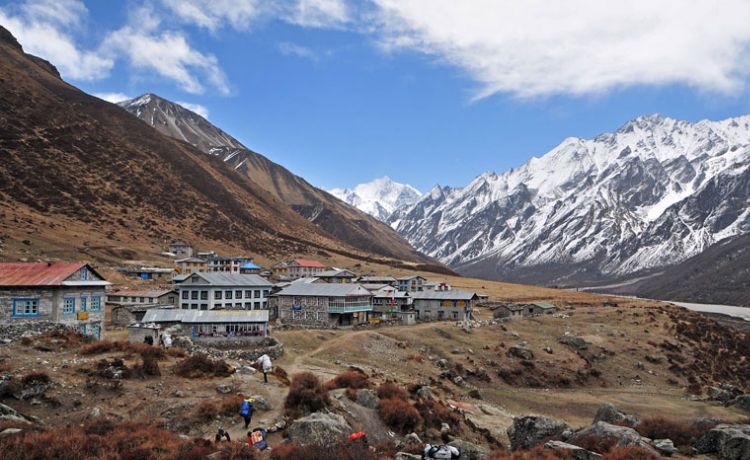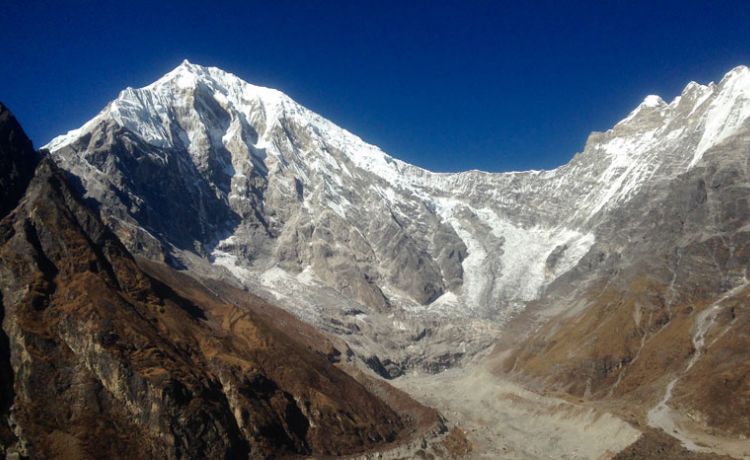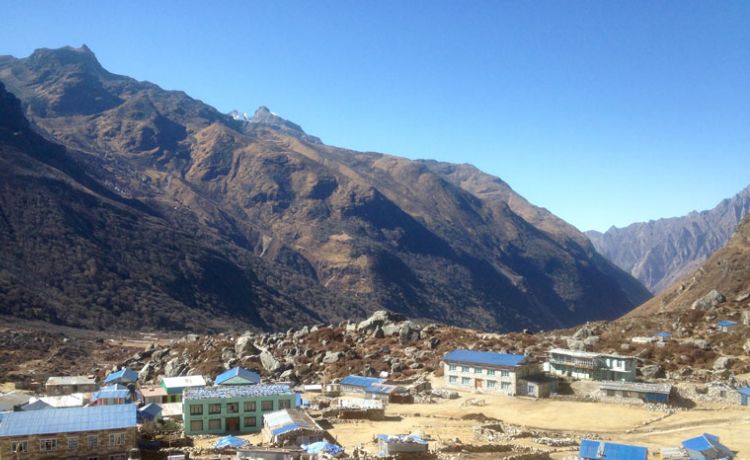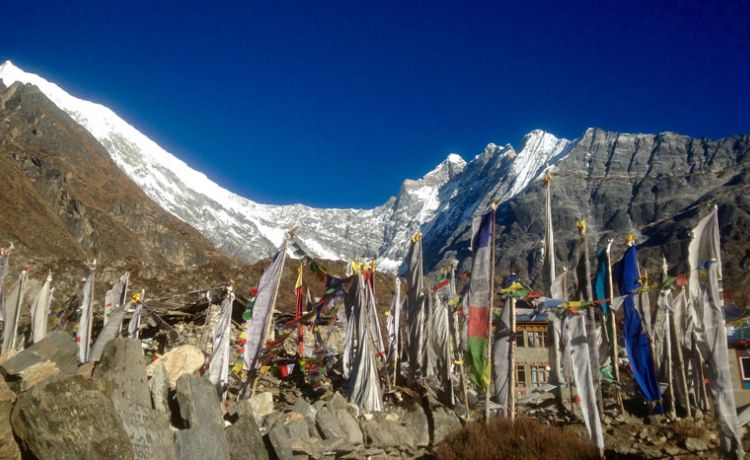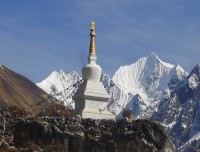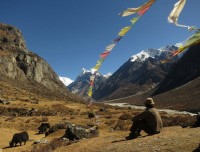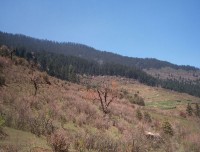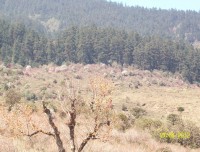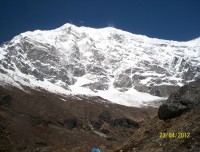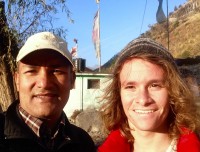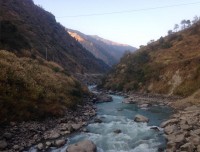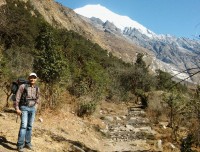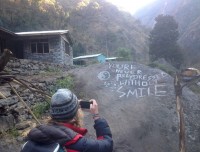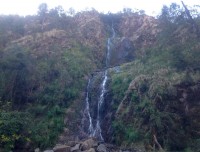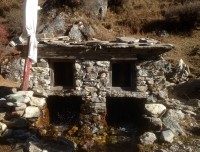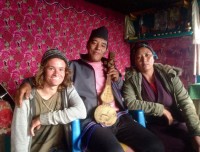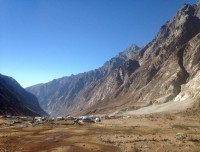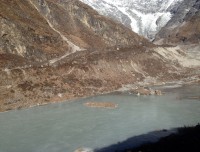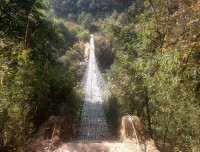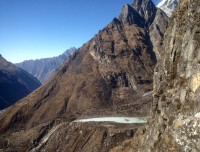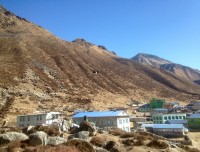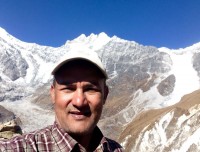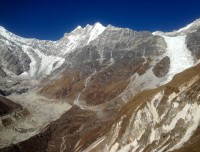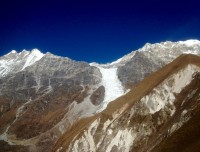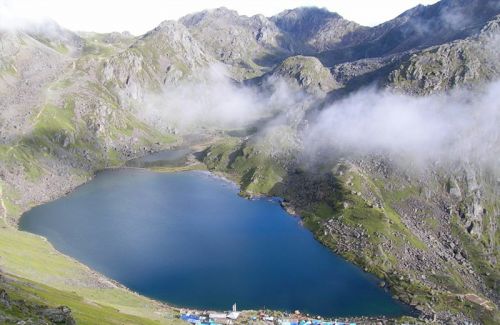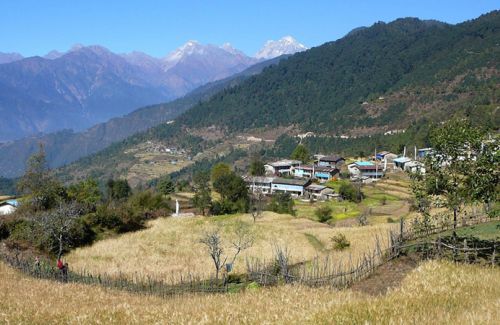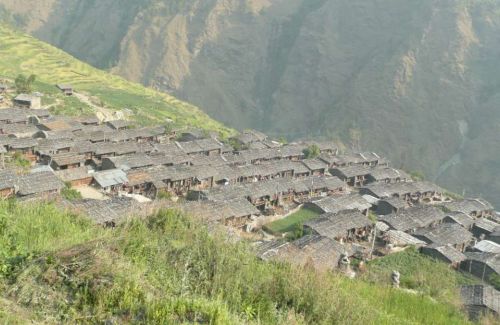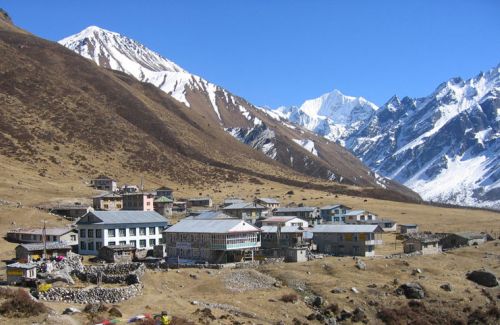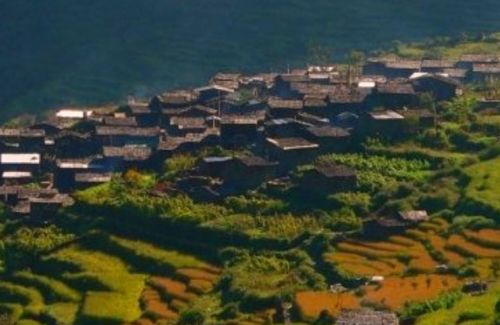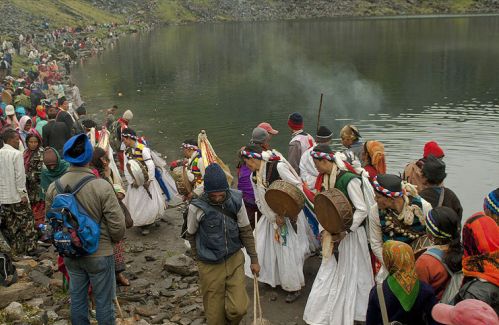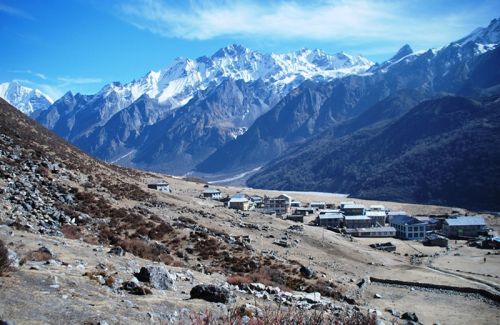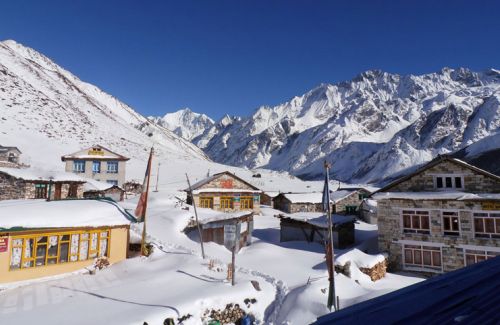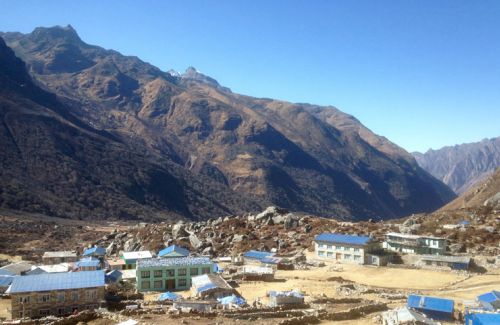Langtang Valley Trekking
- Duration12 Days
- Max. Altitude4,750 m
- Starts FromUSD 950
Destination:Nepal
Trip Grade:Moderate (**)
Meals:Breakfast + Lunch + Dinner
Transportation:Private Vehicle
Accommodation:Lodge
Trekking Region:Langtang Region
Show AllLangtang Valley Trekking is an exciting trekking through superb natural beauty to the nearest view of Langtang. Trekking north of Kathmandu is strangely underrated and uncrowded. Langtang valley is the nearest trekking region from Kathmandu valley in comparison to other known trekking routes. Langtang is the valley nestled in the Himalaya, bordering Tibet to the north and lower elevation mountains to the south. Langtang region is as wild as any Tibetan highlands with idyllic rural landscape. The people dwelling here are of Tibetan origin and have their Tibetan lifestyles. Langtang Valley Trek offers the perfect Nepalese cocktail of promising classic mountain views, wildlife and traditional culture.
Ascending from just 541 m at Trisuli Bazaar to 3870 m at Kyanjing Gompa , the trail passes through an ever changing climate, biodiversity and topographical variations. The Langtang trek enters the Langtang National Park, the first nearest park from Kathmandu before Shivapuri National Park declared in 2002. The Langtang Valley Trekking commences from Syabrubenshi, about 8 hours bus drive from Kathmandu. We follow the steep river gorge passing through a mix of oak and rhododendron. Any steep sections seem to co- inside with many birds and animals distracted in the encounter with grey languor and the birds like cuckoos,barbets,magpies and so on. In the Spring, the forest seems beautifully dressed up with blooming flowers and in Autumn the beriberi bushes, blazing with a deep rust hue. After we pass the National Park, we can see the mighty Langtang Lirung (7,246 m) and Langtang II (6,581 m) dominate the snowy peaked views to the north side, with Gang Chenpo (6,388 m) lying to the south.
The deep river gorge has given the way to the glacial valley which is the yak grazing territory. There is a legend about the valley that a venerable lama followed the runaway yak , discovered the valley. So, the name Lang means “ yak” and Tang means “ to follow”. These days it is referred to the valley of glaciers. Finally, Kyanjing Gompa is the superb place to relax, hike to the Kyanjin Ri and Tsergi Ri , step over the glacier, visiting the monastery and yak cheese factory.
From here it is the downhill as we head back the way we came. While retracing our step back, we can have detailed views of Mani walls and prayer wheel houses. There are different way for further trek as a fork heading to Goshaikunda via Thulo Syabru and Lauribina or to Helambu.
Langtang is the sparsely populated area where the people are found uneducated and there is no impact of modernization. One could enjoy this isolation and shows a deep respect and the appreciation to the natural panorama. Perhaps, you could notice there that how much drier it is on this side of the valley, which because it faces south and receives more sunlight.There are plenty of lodges for the accommodation. Trek Langtang Valley can be done in as little as a week. The best time to trek Langtang is the beginning of February to the end of April and the beginning of the August to the end of the November.
Trip Highlights
- Full day sightseeing in UNESCO World Heritage Sites in Kathmandu
- Scenic drive from Kathmandu to Syabrubenshi
- Walking through the lovely forest of fir, birch, rhododendron and hamlock
- Passing through Langtang Khola, waterfalls, and big boulders
- Walking through open meadows
- Visiting cheese factory in Kyangjing
- Visit the Tibetan village in Langtang Valley
- Bio-diversity in Langtang National Park
- Amazing views of Langtang Ri
- Langtang Glacier and amazing views of Kyangjing Ri
- More chances to encounter the Red Panda and common langur and its habitat
Day to Day Itinerary
Day 01:Arrival in Kathmandu (1,350 m) and Transfer to Hotel. Overnight at Hotel
Day 02:Kathmandu sightseeing and Trek Preparation. O/N at Hotel
Day 03:Drive from Kathmandu to Syabrubensi (1,503 m), 8 hrs. O/N at Guest House
Day 04:Trek from Syabrubenshi to Lama Hotel (2,410m), 6 hrs. O/N at Guest House
Day 05:Trek from Lama Hotel to Langtang Village (3,430 m), 6 hrs. O/N at Guest House
Day 06:Trek from Langtang Village to Kyangjing Gompa (3,830 m), 4 hrs. O/N at Guest House
Day 07:Hike to Kyangjing Ri (4,750 m) early morning and trek back to Langtang Village, 6 hrs. O/N at Lodge
Day 08:Trek from Langtang Village to Lama Hotel (2,410 m), 5 hrs. O/N at Guest House
Day 09:Trek from Lama Hotel to Thulosyabru (2,210 m), 6 hrs. O/N at Guest House
Day 10:Trek from Thulosyabru to Dhunche (1,950 m), 6 hrs. O/N at Guest House
Day 11:Drive from Dhunche to Kathmandu(1,350 m), 117 km, 7 hrs. O/N at Hotel
Day 12:Transfer to International Airport
Cost Include
- Airport picks up and drops off by private tourist vehicle
- A government licensed holder city tour guide
- Three nights’ twin sharing basis accommodation at 3 star category hotels in Kathmandu with Breakfast
- Guided city tour in Kathmandu by private tourist vehicle
- Full board meals (Breakfast + Lunch + Dinner) during the trek
- Lodges, Guesthouses accommodation during the trek
- Professional license holder English speaking Trekking Guide
- The required number of local staff and porters (2 Trekkers = 1 Porter)
- Food, accommodation, salary, insurance, equipment and medicine for all staff
- Langtang National Park Entry Permit and TIMS permit for trekking
- Down Jacket, Duffle bag and sleeping bag by Himkala Adventure if required
- Public transportation from Kathmandu to Sybrubeshi and from Dhunche to Kathmandu
- Farewell Dinner in typical Nepalese restaurant with cultural show
-
Government taxes, VAT and Service charge
Cost Exclude
- Lunch and Dinner in Kathmandu
- Entrance fee in all monuments during tour
- Emergency Rescue and Evacuation cost
- Your travel insurance
- Nepal entry visa fee
- Personal expenses like: phone bill, laundry, hot shower, hot and cold drinks etc
- Personal trekking Equipment
- Tips for trekking, tour staff and driver (Tipping is expected)
-
Any others expenses which are not mentioned on ‘Cost Includes' section
Detail Itinerary
Day 01Arrival in Kathmandu (1,350 m) and Transfer to Hotel. Overnight at HotelOur representative from Himkala Adventure will greet you at the Tribhuvan International Airport and transfer you to the hotel. You could spend the time walking around Thamel. Overnight at Kathmandu
Day 02Kathmandu sightseeing and Trek Preparation. O/N at Hotel After breakfast, we go for guided city tour. First we visit Swoyambhu Stupa, affectionately call it ‘The Monkey Temple”, walk around the stupa, see the Valley view and come to Kathmandu Durbar Square. It is the place where you can see many Hindu temples, Living Goddess Kumari, the coronation chowk in the past and drive about 8 km far to Boudhanath Stupa. It is one of the biggest stupa in southern Asia in terms of its height and expansion. The fourth place for today is the Hindu Temple dedicated to Hindu Supreme God Shiva where you can see the cremation spot. After that we come back to hotel and do briefing about Langtang Valley trekking from the next day. Overnight at Kathmandu
Day 03Drive from Kathmandu to Syabrubensi (1,503 m), 8 hrs. O/N at Guest House After breakfast, we drive to Syabrubeshi which is 145 km from Kathmandu. It takes about 8 hours by bus. After 45 minutes, we pass through Kakani, the best view point for the Mountain View and reach to Trishuli Bazaar, a busy town. The river which flows southwest is popular for rafting. We arrive at Dhunche where we have to pay National Park entry fee and show our TIMS card. This is more or less the gateway to the Tibetan border. Then it reaches to Syabrubenshi via Bharkhu (1,844 m). Overnight at Syabrubenshi
Day 04Trek from Syabrubenshi to Lama Hotel (2,410m), 6 hrs. O/N at Guest House After breakfast, we start climbing up through the oak and maple forests that cover the lower section of the valley and further up by the spruce, fir and blue pine. We descend through the Syabru village and continue down the ridge until we come to a trail to the east that drops steeply of the ridge and through a dense forest. We cross a bridge over the tributary of the Langtang Khola and then climb for a short distance. The trail follows the south bank of the river through a deep gorge crossing another tributary in about half an hour. So, after 6 hours’ trek we finally reach to Lama Hotel. Overnight at Lama Hotel
Day 05Trek from Lama Hotel to Langtang Village (3,430 m), 6 hrs. O/N at Guest House After breakfast at Lama Hotel, we start our trek through forest and tantalizing glimpses of snow-capped peaks can be seen. From the Lama Hotel, the trail climbs steadily to Ghora Tabela (2,880 m) from where Langtang Lirung can be seen great. Then, the trail becomes steep for a while. At Ghora Tabela, the trail leaves the forest and comes to the Tibetan Resettlement Camp, which is now an Army Post. After this, the trail gradually ascends up to the Langtang village, after below the monastery. We can see the flat roofed Tibetan houses and open pastureland there. Overnight at Langtang Village
Day 06Trek from Langtang Village to Kyangjing Gompa (3,830 m), 4 hrs. O/N at Guest House After breakfast, we go ahead to U –shaped valley. Leaving Langtang, we gradually ascend to chorten behind which is a very long Mani wall. The trail passes two small villages and the village widens. We cross many streams and a moraine before arriving at Kyangjin Gompa. Between Langtang and Kyangjin, the view of Yansa Tsenji, and Kimshun to the north and the Langtang Himal to the northwest seem magnificent. Overnight at Kyangjin Gompa
Day 07Hike to Kyangjing Ri (4,750 m) early morning and trek back to Langtang Village, 6 hrs. O/N at Lodge Hiking further up the valley is an unforgettable experience passing the airstrip which offers the fascinating views of Langtang Lirung, Ganchenpo. Langshisa Ri,Dorje Lakpa, Lenpo Gang, and Urkinmang.But we hike to Kyangjing Ri, one and half an hour walk to the nearby hill. We return back to hotel, get breakfast and retrace back to Langtang village. Overnight at Langtang Village
Day 08Trek from Langtang Village to Lama Hotel (2,410 m), 5 hrs. O/N at Guest House After our breakfast, we retrace back to Lama Hotel. It takes about 5 hours from Langtang Village. Overnight at Lama Hotel
Day 09Trek from Lama Hotel to Thulosyabru (2,210 m), 6 hrs. O/N at Guest House From Lama Hotel, we trek down to the place named landsslide and turn left from our side to Thulosyabru which takes about 6 hours. Overnight at Thulosyabru
Day 10Trek from Thulosyabru to Dhunche (1,950 m), 6 hrs. O/N at Guest House After breakfast at Syabru Benshi, we drive back to Kathmandu via Dhunche, Trishuli Bazaar. It is about 8 hours drive through hill, streams and scenic beauty. In the evening, we celebrate the dinner together with Nepalese Cultural show. Overnight at Kathmandu
Day 11Drive from Dhunche to Kathmandu(1,350 m), 117 km, 7 hrs. O/N at Hotel After breakfast at Syabru Benshi, we drive back to Kathmandu via Dhunche, Trishuli Bazaar. It is about 8 hours drive through hill, streams and scenic beauty. In the evening, we celebrate the dinner together with Nepalese Cultural show. Overnight at Kathmandu
Day 12Transfer to International Airport We transfer you to the Tribhuvan International Airport 3 hours prior to your scheduled flight, if you have enough time before departure, then you could walk around the bustling local market around Asan, buy some typical Nepali spices, garment stuff and others then proceed to the Airport. We would like to thank you joining Himkala Adventure to trek to Langtang Valley Trek and wish you have safe journey to your onward destination. Namaste!!!
Trip FAQ
Himkala Adventure would like to answer all the queries about Langtang Valley Trekking for all curious travelers/trekkers in the world. As you are entirely from different geographical location, you could better to know everything about the treks from the beginning i.e. airport pick up till your departure like airport picks up, drops off, accommodation in city, in the trek, guide and porters, safety for the trekking, food and accommodation and some other things that you might face on the way. Hope our endeavor listing these questions answers will help you self informed.
This is simply the outlines of the services we offer but it may differ as per your requirement, number of trekkers. What we go through our conversation, we will manage the means of transportation, hotels in the city, accommodation in the trekking, numbers of porters etc. This is general idea about Langtang Valley Trekking before your trip and you become clearer about the trek. Please feel free to contact us to get more information about the trekking in the Himalayas of Nepal.
1) How is Langtang Valley Trekking in Nepal?
Langtang Valley is the nearest Himalayan Region from Kathmandu valley. Despite being very close to Kathmandu, the Langtang Region is as wild as any Tibetan highlands with peaceful rural landscape. The people living in the highlands of the Langtang region are certainly Nepalese but being the descendant of the Tibetan origin, they look like the Tibetans.
2) What physical fitness do I need to book this trip?
Every trekking in the Himalayas of Nepal requires the certain level of physical and mental fitness. So, we advise you to be in good physical shape and able to feel comfortable while hiking up and down 7 to 12 miles per day on a trail carrying a day pack of about 10 pounds. Three things could make you confident enough for any trek you would like to do: aerobic, strength and mental.
Aerobic conditioning is important primarily because you will be trekking in thinner air, up to 40% less than at sea level. With good aerobic conditioning, you will be able to better metabolize whatever oxygen is available to you. You should plan on doing at least one hour of aerobic 3 /4 times per week for 1 month or more before your arrival in Nepal. Walking, jogging, cycling, hiking on valley floor to ridge line ascents with day back are some of the excellent forms of exercise, so long as you are strengthening leg muscles and building stamina. Speed is not the essence; stamina, confidence and continuity are. Do as much uphill as possible. If you live in flat area, go to the stadium and use the steps with your pack.
3) Do I really need to use guide to Langtang Valley Trekking?
You are advised to use Guide so that you could feel safer in the unknown area because the guide can tell you the possible danger as they have guided in this region since long. Most importantly, the Himalayan weather is really unpredictable and the Guide can help you to take proper shelter. Nest advantage to be with Guide is you get more knowledge about local culture and you could have easy access to interact with the local people. In 2014, the Nepal Government clearly has stated that the trekkers should have a guide but still it is not seemed in the practicality.
4) How do I find Himkala Adventure for my pick up at the airport?
Our representative from Himkala Adventure will display a small board (placard) of company or your name outside the airport terminal. You will be driven to the hotel by our tourist vehicle.
5) What sort of accommodation do I get in Kathmandu?
Normally we provide standard rooms with twin sharing accommodations at three star or similar category hotels in Kathmandu including breakfast. Accommodation in these cities can be upgraded as per your request. But some of our packages are sold without accommodation in the city.
6) How are tea house facilities during Langtang Valley Trekking?
Tea House is the combination of guest house, restaurant, and social hang out. Tea houses in Langtang Valley Trekking area are professional though they are simple but with neat and clean lodging offering fine views and plain but fresh and hygienic food with friendly atmosphere Most of the Tea Houses have running water facility. Many of them have hot water available for bathing. But we discourage our groups from using water heated by wood as lack of firewood in most villages is a big environmental concern in Nepal.
7) What sort of accommodation do I get in trekking?
Guesthouses/Tea Houses/Lodges provide twin sharing single and double rooms and occasionally a dormitory which is basically clean with a mattress and a quilt or blanket. Our company provides the sleeping bag if needed but we always recommend having your own sleeping equipments. You have to share the room with your group member or sometimes with unknown traveler. The toilet is always outside the room with basic facilities.
8) What sort of foods, water and drinks can I expect in trekking?
The foods in the Himalayas are very simple. There are mostly the family members themselves to cook and serve the meal. They are simply trained but experienced because they have been offering such services for many years in this busy route. The food is hygienic, fresh and delicious. We recommend you to drink mineral water or the boiled or using water purification pills or drops.
Most of the foods are cooked in the kitchen of tea houses. They serve you with different varieties of delicious Nepali and continental dishes. The most popular Nepali food is daal bhat (rice and lentils) with some mixed vegetable curry. Garlic soup is popular as it helps you with acclimatization. You could better be vegetarian in the mountains. All hotels in cities and guesthouses in trekking serve the vegetarian food. You can find all common types of drinks like hot chocolates, coffee, tea, hot lemon with honey, ginger tea, soft drinks etc. you will have your breakfast and dinner at the lodges where you will be staying and lunch somewhere on the way to your next destination.
9) What mode of transportation do I use?
We will provide the private transportation for Airport/Hotel/Airport pick up and drop and sightseeing in Kathmandu Valley. We use transportation as based on our cost inclusion section. The transportation varies depending on your requirements at the time of booking the trip.
10) What is the best season for this trekking?
The best season for Langtang Valley Trekking is spring (March to May) and autumn (September to December). These are the perfect time of the year for the breathtaking views of Himalayas with clear and sunny days. But the weather in the mountains is unpredictable.
11) What is the weather and temperature like during the trekking?
The climate in Nepal varies from place to place which can be categorized in different four main seasons. The main seasons in Nepal are spring (March to May), summer (June to August), autumn (September to November) & winter (December to February). The best season to travel in Nepal is autumn (September, October & November) & spring (March, April & May). Weather in the mountains is unpredictable. But the day temperature in Langtang Valley Trekking is comfortable.
12) Who will be guiding me during this trip?
We provide the professional government license holder English speaking trekking guides for our entire trekking trip. We can also provide French, Spanish, Japanese, German or Italian speaking guides as per your preference with extra payment but not guaranteed. All guides will be Nepali people who are carefully selected on the basis of their appropriate experience, leadership skills and personality. They are all trained from Nepal Academy of Tourism and Hotel Management, certified and approved by the Tourism Department of Nepal government. We provide a different city tour guide to guide you in UNESCO World Heritage Sites in Kathmandu. They are the professional license holder guide specialized in culture, history, geography, iconography, archeology and religion with good command over English. Tour guides are specialized in city tour and trekking guides are more in the hiking and trekking in the Himalayas.
13) What sort of experience do your guides have?
Our entire city tour guides have bachelors to Master Degree academic education along with many months tour guiding training from Nepal Academy of Tourism and Hotel Management, Rabi Bhawan, Kathmandu, Nepal. They are fluent in spoken languages and informative about the sites in many aspects. They are quite experienced and dedicated to their job and responsibilities.
Our entire trekking guides have minimum Intermediate to Master Degree academic education with trekking guide training from Nepal Academy of Tourism and Hotel Management, Rabi Bhawan, Kathmandu, Nepal. Many of them are from villages. As they are local, they know more about the routes, necessary precaution to be taken and so on. They have spent many years exploring many parts of the country. They are trained in first aid and able to handle any situation easily. They speak good English and make you know about the places you visit.
14) May I charge my electronic gadgets during Langtang Valley trekking?
Most of the places in your tea houses have charging facilities. You can charge your devices by paying some extra money. It’s good if you bring TWO or THREE pin travel adapter and put your gadgets at warm place at night.
15) How much additional money is required for this trip?
It’s a very personal question as expenses depend on habit. Normally, in Kathmandu you can allocate about USD 10 to 15 per person per lunch or dinner. USD 10 to USD 15 per person per day will be sufficient to buy bottles of water, chocolates, pay for a hot shower during the trekking. Other personal expenses will be your own calculation.
16) What is the social and environmental responsibility of Himkala Adventure for this trip?
The situation of environment in Nepal is in considerable stage due to so many factors caused by global warming, human activities, and adverse effects of natural incidents. Nepal is in between two giant countries like China and Nepal. The ozone layer is depleting and the atmosphere is getting heated. So, its direct effect is to the Himalayas that the snow is melting day by day and the sea level is rising. It is due to population growth, people are clearing the forest and the soil is being eroded. As a part of society, and our trekking related activities are directly concerned with the social and environmental things. We are very conscious not litter in the open spaces, to manage garbage properly and make local people aware in this campaign. We are working together with other companies and taking these issues seriously.
17) What is the minimum number requirement for this trip?
We operate individual trip to the group joining trips for Langtang Valley Trekking. If you want to do any private trip we are ready to organize for solo traveler as well with some additional charges.
18) Are there communication or internet services during Langtang Valley Trekking?
All our guides carry the local mobile phone. You can use his mobile phone to make any local or international call from trekking trails by paying him directly. You can even pass him number to be connected with your family or friends. We highly recommend taking local SIM card for call and internet services during trekking. Local SIM cards are easily available in many stores and at airport as well. You need to provide two copies of your photographs and your passport copy to get local SIM CARDS of NCELL & NTC (only these two companies provide telephone services in Nepal.
19) May I get chances for shower during Langtang Valley Trekking?
Most of the guesthouse provides hot shower with some extra cost. In few places, bucket water will be provided for the shower.
20) May I add extra days in trekking?
Yes. You can customize the trek as you would want. We are flexible while preparing the itinerary and you could lengthen or shorten it as per your requirement.
21) What happens in case of emergency?
Himkala Adventure has prepared for any emergency situation and knows how to handle it. Our guides are trained in first aid and can deal with most of the basic ailments that occur during the trek. Every client should have his own insurance before coming to Nepal for the case of emergency.
22) Do I need to have insurance for this trip?
We request you to have a travel-insurance policy to cover theft, loss, medical problem & emergency helicopter evacuation from high altitude places before coming Nepal. Choose a policy to cover your emergency high altitude helicopter evacuation with all medical insurances for trekking in high altitude in the Himalayas of Nepal. Your travel insurance is always needed before going in any high altitude trekking. Please check your travel insurance policy which doesn’t exclude mountaineering or alpinism. Although you will not be engaging in these activities in your trekking, you might have problem convincing the insurance company of this fact. Rescue insurance need to cover an emergency helicopter evacuation or a charted flight from remote mountain trails of Nepal as well as international medical evacuation. A helicopter evacuation might cost US$ 2500 to US$10000 depending on the places. So that travel insurance to cover all above is must to travel in the high Himalayas of Nepal.
23) What type of shoes should I wear during Langtang Valley Trekking?
You could better have carefully chosen hiking boots with extra laces which should be kind of strong, well-made but light boots for Langtang Valley Trekking. Shoes and boots are best to buy before arriving in Nepal. We advise you to wear your new shoes for sometime before trek so that you could feel well habituated on the newer trail for your feet.
24) Can I use credit cards in the Langtang Valley Trekking route?
No, you can use only in the cities like Kathmandu. So, it is better you to make change in Kathmandu. When you are out of city, all you need is cash, better to have small notes. Please change the currency in local Nepali rupees before you go to the mountains.
25) Do I need to tip my guide and porter? How much would that be?
Tipping is not mandatory, neither it is right to ask by anyone but it is a way of showing gratitude after taking service. The level of tip also shows how satisfy you are from the team that you had been during your tour/trek.
However, we recommend you to spend minimum 10% of your total trip cost for tipping entire local staffs, the ratio of tipping guide and porter will be given to you at the pre-trip meeting in Kathmandu before starting the trek.
26) How is Camping Trek to Langtang Valley being operated?
Camping trek is fully organized and supported, with a team of guides, cooks, and porters to accompany you. Our porters carry all the trekking gear, food, fuel and personal belongings. Our cooks prepare hot meals. Trekkers need only carry a small bag as required for the day. At night, tents for dining, sleeping and ablutions tents are provided and set up, also mattresses and down-filled sleeping bags, tables and seating.
In a typical camping trek, we start the day around 6 a.m. with a cup of hot tea. You are then provided with a bowl of warm water for washing. Then trekkers enjoy breakfast before leaving camp. The trek begins around 7.30 - 8 a.m.
Trekkers can set their pace for pausing and sightseeing and the walk to the lunch spot will normally take 3 hours. On arrival, you are served hot lunch. In the afternoon, after walking for another 3 to 4 hours, you arrive at the next camp around 5 p.m. Tea & snacks are served while our staff readies the camp. Dinner time is around 6/7 p.m. in the dining tent, lit with lanterns and comfortably furnished. The food is healthy, wholesome and hygienically prepared.
Trip Note
Cost:
The cost of trip varies according to the number of travelers in the group, the category of the Hotel, mode of the transportation and any kind of changes (if there is). So, if you would let us know all of these above mentioned things, then we could quote you the exact price.
Essential documents:
You are requested to send the following documents after you confirm or book the trip with Himkala Adventure:
A copy of your passport and travel/health insurance documents with contact details, three passport size photos.
It is advised to maintain a separate photocopy of all important documents including traveler’s cheques, bank/ATM card, contact numbers, international flight tickets, and emergency contact numbers.
Weather:
The main trekking season in Nepal is from October to December and March to May. The day temperature for walking in Langtang Valley Trekking is comfortable. The sky is clear although there is snow and rainfall occasionally. It is about 10 degree centigrade at the height of 3,600 m and increasingly lower, the higher we go.
Nepal Strikes:
There is much more progress in the political scenario in Nepal and we assure you that travelling in Nepal is safe. But there may be Bandha (wide transport strikes) at a very short notice. The shuttle bus is in operation by Nepal Tourism Board and the Nepal Tourist Police in conjunction with the Himalayan Rescue Association from domestic and international terminal to the various hotels in Kathmandu. The service costs 300 rupees per person.
Itinerary Disclaimer:
Himkala has thoughtfully designed all the itineraries but our itineraries are updated for the betterment on the basis of our past travelers’ comments and our own research. In case you find changes in the itinerary you printed and the upgraded one does not affect your trip. Please note that some changes may occur in our itineraries due to bad weather and common seasonal changes to timetables and transport routes.
Physical Rating:
Your trip will be meaningful if you could find yourself fit and fine. You will be walking up to 4,750 m from the sea level. As the geographical region varies, there is a temperature variation as well. So, we advise you to undertake regular physical exercise, jogging, hiking, riding, ascending and descending the long stairs etc. Precautions and acclimatization are undertaken but be aware of the effects altitudes can have.
Group Size:
Himkala Adventure organizes solo to group travelers. Our group trips are designed for sharing accommodation and there is no single supplement. Single travelers share with the same gender from twin to multi-share in an accommodation. You are requested to have mutual understanding in between the fellow travelers who have joined from the different parts of the world. Please remember that you have great responsibilities in the group. If you are requested to be at a particular place at a certain time, make sure that you have been there at a time. It is much more pleasing sharing experiences and traveling together.
Accommodation and Meals:
Accommodation and Foods in the Himalayan region of Nepal cannot be compared with any developed countries in the world. We know that you might not have experienced such things before but you should take it easy. Accommodations at local lodges are simple but clean and comfortable. The food is plain. Toilets and washing facilities are shared and rudimentary. In high altitude regions, there are very few tea houses and one has to be happy to share in simple dormitories without electricity, without running water. Hot shower means a bucket of hot water upon our request.
Money Matters:
Please note that most establishments in Asia will not accept foreign currency notes that are old, torn or faded and they can be very difficult to exchange or extra fees added when exchanging at banks. Please ensure that you have new, clean notes.
The official currency of Nepal is the Nepali Rupee (NPR). ATMs can be found only in major cities of Nepal like Kathmandu, Pokhara, Chitwan, Bhaktapur etc. The government of Nepal has banned the import, export and use of 500 and 1000 Indian rupee notes in Nepal. You make sure that you won’t carry these notes upon arrival in Nepal, otherwise they are confiscated and you may be fined.
Please make sure that the foreign currency notes that you have are new and clean notes because old, torn or faded foreign currency notes in Nepal are very difficult to exchange or extra fees added when exchanging at banks.
While travelers cheques have security advantages exchanging them can be a lengthy process, commissions can be high (up to 10%) and they can be difficult to change in rural areas, on weekends and public holidays. If you choose to bring travelers’ cheques, make sure they are a major brand and major currency.
Tipping:
Tipping is not mandatory. It is not anyone’s right asking for tips but if you are happy with the service, you could tip the staffs. It is entirely a personal preference. Tipping could be significant to them who took take great care of you in your traveling period. Himkala recommends that you could tip any intended recipient by any member of the group than collected and passed on by the group leader.
Note: Please do not tip with coins or dirty and ripped notes. This is culturally taken as an insult.
Local Dress in Nepal:
Nudity is a sensitive issue in Nepal. Women should avoid wearing shorts and sleeveless tops in public places where this might be seen as inappropriate. Remove shoes before entering certain holy places. Non-Hindus are not permitted in some temples.
Feedback:
Your feedback will be the great guidance to meet our target and to bring improvement in our service. What and how have you experienced with Himkala Adventure and our staff? Please write, we will read it carefully. One cannot see his/her shortcomings that are lying with them. Someone should point it out. We are always eager to hear from you.
Trip Info
- Cross Cultural Issues
- Essential Do’s and Don’ts
- Foot Ware/Foot Care
- Health and Fitness
- Himkala Crews
- Hypothermia
- Safety and Security
- Travel Insurance and Evacuation
- Trip FAQs
- Washing and Shower
- Water/Food and Nutrition
- Trip Grading
- Weather
- Accommodation/Shelter
- Altitude Sickness
- Communications and Updates
- Conservation
- Equipment List
What our clients say?
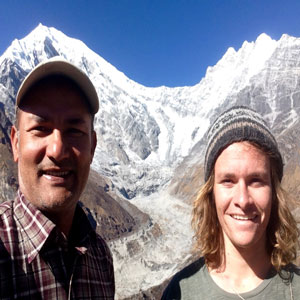
With Himkala Adventure I did a free walking tour of Kathmandu, a trek to Ghorepani and Poon Hill, and finally a trek the Langtang region. The walking tour was an…...
Nathan Squire, Australia
Read More